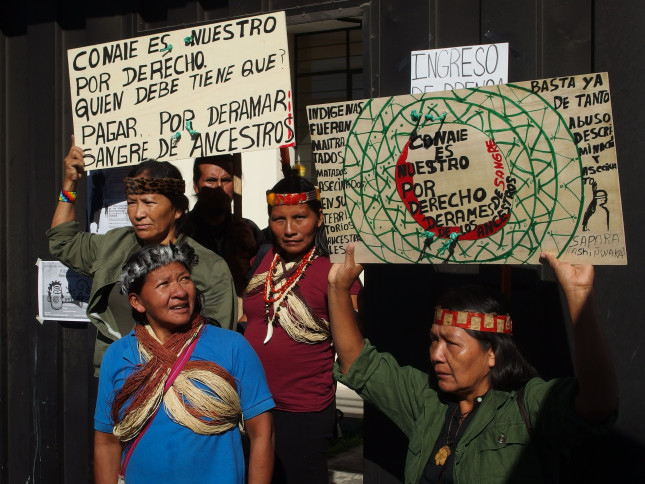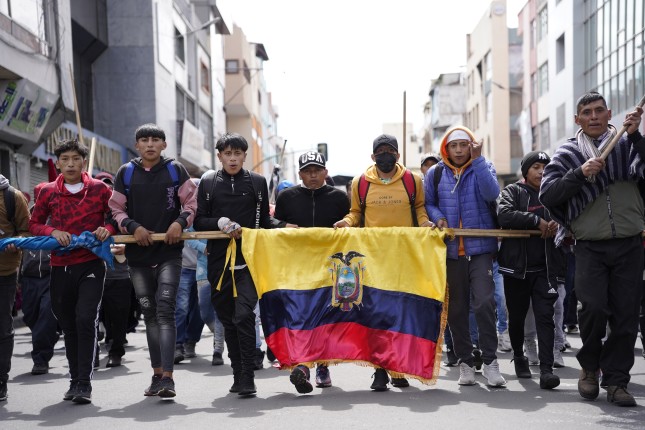-
Buen Vivir in Ecuador: An Alternative Development Movement for Social and Ecological Justice
December 8, 2022 By Yiran NingEarlier in 2022, Ecuador’s capital was left “virtually paralyzed” after some 14,000 people, mainly Indigenous Ecuadorians, participated in 17 days of sometimes violent nationwide protests. The actions forced the Lasso government to the negotiating table for a 90-day dialogue with Indigenous leaders. By early September, the parties signed a temporary moratorium on the development of oil blocks and the allocation of new mining contracts. Many Ecuadorians and international observers see this latest cycle of protests as a manifestation of the larger clash between the government’s highly extractive approach to development and the Indigenous movement for Buen Vivir — an alternative model that centers on social and ecological well-being. At present, the Ecuadorian government’s heavy reliance on natural resource exploitation and weak political will have cast doubt on its ability to fulfill its promises on Buen Vivir. Yet the Indigenous movement’s organization of transnational coalitions and large-scale protests could hold the key to pushing Ecuador onto a path of more socially and ecologically just development.An Alternative Paradigm to Extractive Development
Buen Vivir (or Sumak Kawsay in Kichwa) translates roughly into English as “living well.” Alongside parallel efforts in Bolivia and Chile, Buen Vivir has emerged in Ecuador as a political and cultural proposal to address the social and ecological destruction brought about by extractive development. Early efforts to bring these principles into governance were promising. After gaining crucial Indigenous support and being elected president in 2007, Rafael Correa and his government collaborated with Indigenous groups to develop a new constitution that promoted the principles of Buen Vivir, including a provision that made Ecuador the first nation in the world to grant constitutional rights to nature. The Correa administration also published the 2009-2013 National Plan for Good Living, a longer-term strategy to guide Ecuador’s public policies and programs towards Buen Vivir. However, these initial efforts and promises to radically reform Ecuador’s economy did not result in substantial shifts on the ground. The development of Ecuador’s two largest copper deposits — the Mirador and San Carlos Panantza mines — continued to threaten ecologically and culturally significant areas in the Ecuadorian Amazon. The Chinese mining consortium that acquired these mines in 2010, CRCC-Tongguan, forcibly displaced Indigenous Shuar communities and then colluded with the government to circumvent social and environmental regulations. These extractivist development policies fundamentally contradicted the principles of Buen Vivir.Buen Vivir Ideals Still Unmet
Buen Vivir principles have failed to take hold in Ecuador because the nation’s economy has been caught in a vicious circle of heavy reliance on natural resources and borrowing for mining development. In an interview, Rebecca Ray, Senior Academic Researcher at the Boston University Global Development Policy Center, explained that in 2008, the Correa government classified its debt as “odious” and defaulted on its Global Bonds maturing in 2012 and 2030 — obligations due to official and private creditors to sustain high levels of government spending. Ecuador was consequently shut out of the Western bond market and turned to Chinese commodity-backed loans for much-needed credit. From 2005 to 2011, China provided $6.3 billion out of the $8.9 billion that Ecuador received as loans. However, when the commodity boom ended in 2011 and prices of Ecuador’s oil and mineral exports fell, the government was forced to further exploit its natural resources to repay its debt. Early in its tenure, the Correa government actively tried to develop an alternative to natural resource exploitation, but it could not obtain the international investments necessary to succeed. The government’s proposal to abandon the exploitation of billions of dollars worth of oil drew significant resistance from transnational corporate actors and importing countries. One clear example is the Yasuní-ITT initiative. This plan saw Ecuador’s government request $3.6 billion from the international community within ten years to fund renewable energy development, with the intention of imposing a moratorium on expanding the country’s oil frontier in return. After collecting only $10.5 million in two years, Correa’s administration resumed oil extraction in Yasuní National Park, declaring that “the world has failed us.” Internal disagreements within the government also gradually eroded the political will to end the country’s dependence on natural resources. Cintia Quiliconi, an Argentine Associate Professor at Ecuador’s campus of the Latin American Faculty of Social Sciences (FLAC-SO-Ecuador), explained that the divergence between Buen Vivir promises and practice had pushed advocates of stronger environmental protections to leave the government.The Promising Role of the Indigenous Movement
Ray and Quiliconi both pointed to the growing power of the Indigenous movement as the most promising way to reinvigorate the push for Buen Vivir. The Confederation of Indigenous Nationalities of Ecuador (CONAIE), founded in 1986, has established itself as a legitimate political voice in the national discourse. Often referred to by scholars as “the best-organized and most influential indigenous movement in Latin America,” it has been the driving force behind nationwide protests calling for policy reforms aligned with Buen Vivir principles. Ray said that the Indigenous movement’s capacity to mobilize and form transnational coalitions and networks across Latin America is a pathway to instituting higher social and environmental standards for foreign investments. She explained that when the Correa government was struggling to repay its debts, it turned to flexibilización, namely relaxing its environmental and social protections, as it feared investors would be less willing to invest under stricter regulations. Ray added that her forthcoming study on Chinese investments across Latin America shows this was a false assumption — stricter regulations did not result in a significant drop in Chinese investment levels. Quiliconi cautioned that regulations set on paper can be circumvented by companies in practice. Yet she also expressed optimism about the growing power of the Indigenous movement. By organizing some of the country’s biggest strikes, Indigenous Ecuadorians have been able to force the government to the negotiating table to fulfill its promises. Their wins include debt forgiveness for small-scale farmers, fuel price subsidies for the most vulnerable, and an oil moratorium until Indigenous people’s right to free and informed consent is enshrined in law. Decades of struggle by Indigenous groups for Buen Vivir demonstrate that obstacles persist both within and beyond Ecuador for an alternative development model to be realized. However, the growing intensity of the climate crisis and increasing recognition of the harms of resource extraction give urgency to the Indigenous movement’s push for a more holistic understanding of human and non-human well-being. Guided by the principles of Buen Vivir, the Indigenous movement has and will continue to take the lead in agitating towards a more just and prosperous society.This blog is part of the Wilson Center-East-West Center Vulnerable Deltas project that is diving into climate, plastic waste and development threats to three SE Asian and two Chinese deltas. The project is supported by the Luce Foundation.
Ning Yiran is a final-year Environmental Studies major and Global Affairs minor from Yale-NUS College in Singapore. This past summer, she worked as a Staff Assistant Research Intern for the Wilson Center’s Environmental Change and Security Program. She also previously interned remotely at Greenpeace Southeast Asia to support research on climate justice activism in the region. She hopes to contribute to research, public advocacy, and building effective partnerships and networks for environmental and climate justice in Southeast Asia and beyond.
Sources: BBC, Becker Friedman Institute/University of Chicago, Cambridge University Press, Capitalism Nature Socialism, Center for Digital Scholarship/Brown University, Committee for the Abolition of Illegitimate Debt, The Dialogue, Food and Agricultural Organizations of the United Nations, Foreign Policy, The Guardian, Human Rights Watch, Latin American Perspectives, The New York Times, Rapid Transition Alliance, Reuters, Routledge
Photo credits: Lead image: Indigenous Shuar native women from Ecuadorian Amazon protest against mining and oil concessions outside the Conaie headquarters in Quito, Ecuador in 2015, courtesy of Diego Sugoniaev/Shutterstock.com; In-text image: People protest against President Guillermo Lasso’s economic and environmental policies, in Ambato, Ecuador, June 20, 2022, courtesy of Daniel Constante/Shutterstock.com.
 A Publication of the Stimson Center.
A Publication of the Stimson Center.





